#parashakti
Explore tagged Tumblr posts
Text
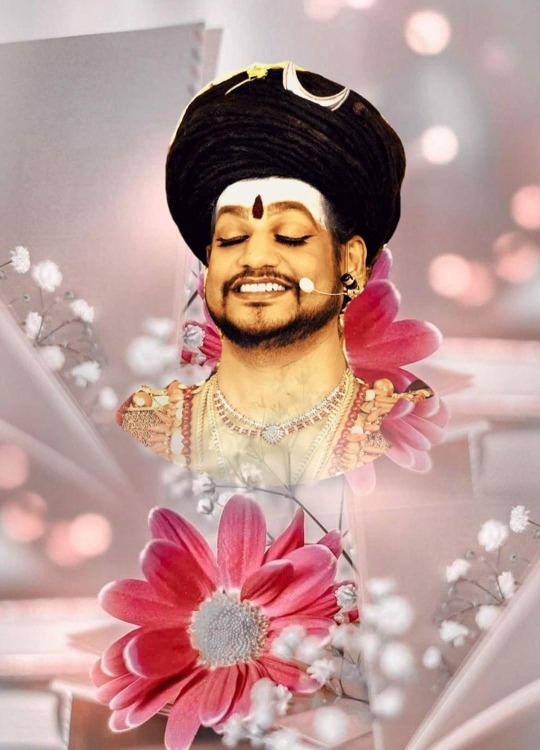

Join us in the next few hours for the live Parashakti Akashic Readings by the SPH Bhagavan Nithyananda Paramashivam and experience the manifestation of Devi Parashakti, the cosmic mother.
Ask all your questions and catch a glimpse of her unconditional divine love.

0 notes
Video
youtube
PARASHAKTI AKASHIC READINGS || Connect with the divine cosmic mother #de...
0 notes
Text

before i even begin dissecting everything wrong with this exchange (a herculean task that could take a lifetime), let’s talk about the irony here: of all the forms of shakti, talia aligns most closely with the archetype of goddess sati.
kali, the fiercest manifestation of adi parashakti, is the destructive force—the wrath, the end. even durga, the warrior goddess, would arguably be a closer match. (also, with the league's stronghold in calcutta, i imagine talia has witnessed the nine days of durgo pujo at least once.)
but no, it’s sati—dakshayani, “daughter of daksh”—who fits talia’s essence. torn between her love for her ascetic husband, shiv, and her devotion to her father, daksh prajapati (literally, “agent of creation”), sati embodies the eternal conflict talia carries. like talia, she is a beloved daughter, bound to a father whose cruelty eventually leads to tragedy.
sati left the opulence of her palace to live on mount kailash with her husband. the cold, the unyielding and the divine terrain is to shiv what gotham is to batman.
shiv himself is the all-forgiving, the redeemer, the eternal constant, above all else. doesn't that sound familiar? shakti, whether as sati or her other forms, his eternal consort and equal, is his balance and his strength.
the cruelty of daksh has such a clear mirror with the needlessly villainous way ra’s al ghul is often written.
talia could also align with goddess parvati—“she from the mountains,” the reincarnation of sati. parvati, with her rational and supportive father himavan (the personification of the himalayas), is the one who brings shiv back from his reclusive despair after sati’s death. in prayers and chants, lord shiv is titled as "parvati pyaara" — parvati's beloved. two forces, bound eternally, drawn together and balanced in ways neither can fully resist nor escape. the layers! the symbolism! and yet, here we are.
✦•┈๑⋅⋯ ⋯⋅๑┈•✦✦•┈๑⋅⋯ ⋯⋅๑┈•✦✦•┈๑⋅⋯ ⋯⋅๑┈•✦✦•┈๑⋅⋯ ⋯⋅๑┈•✦
#brucestalia#thank you for coming to my ted talk#wow i really do yap a lot#ramblingsfromthecave#batshapedthoughts#bruce and talia#brutalia#talia al ghul#bruce wayne#batman#ra's al ghul#dc comics
70 notes
·
View notes
Note
Whenever i reread the Rukmini Svayamvar leela i giggle so much like HELLO?? THE ROMANCE?? SRIMATI RUKMINI BEING AN ABSOULTE CUTIE?? KANHA?? AHHH *swoons and falls dramatically on the floor*
(for the ones who dont know)
A lot of people only know about Rukmini Haran, but Harivamsa (Mahabharata) also gives a detailed account of Rukmini Svayamavar, to which the Yadavs weren't invited. However, Krishna being dramatic as usual (especially for his Shris) decided to disrupt the occasion. Apparently, he was so formidable and intimidating that even the Kings participating in the event requested King Bhishmak to wed Ma Rukmini to Krishna right now in order to pacify him. But as we know, Kanha lets Shri decide the auspicious time for their divine union. (btw Krishna is still in Mathura i.e, Dwarka isn't built just yet.)
Shri Krishna then proceeds to give a speech to the entire Royal court revealing the true nature of Shri Rukmini as Parashakti who has descended on earth upon the request of Brahma and other gods. Being the supreme goddess herself, she deserves only to be wedded to the Supreme lord and not to some mortal king.
" Lord Krishna: O king, I reveal to you an eternal truth, devoid of any deceit. Your daughter Rukmini, upon hearing my words, shall determine the most auspicious course of action. For, at the behest of Brahma himself, she has incarnated in your household as Rukmini, she is the supreme goddess Shri herself "
"She transcends mortal existence, and her presence at the svayamvar amidst human kings would be travesty. As the supreme Goddess, her dharma dictates that she unite with the supreme one alone."
श्रीरुक्मिणीचरणारविन्दार्पणमस्तु ।
BONUS:
*swoons with you*
*Kanha also swoons hearing about his beloved Rukmini*
Shri Rukmini : giggles and shakes her head at all of us
#rukminikrishna#rukmini#krishna#someday i am gonna make a separate post for it#his speech about her also feels like he is addressing all the people of kaliyug who dare disrespect her#hinduism#hindublr#krishnablr#devotion#krishmini#desiblr#dwarka#gopiblr#mahabharata#ashtmahishi#ashtbharya
96 notes
·
View notes
Text

Ganesha ॐ
Lord Ganesha: his birth story, symbolism meaning and practice
The birth of Ganesha
One day Goddess Parvati was at home on Mt.Kailash preparing for a bath. As she didn’t want to be disturbed, she told Nandi, her husband Shiva’s Bull, to guard the door and let no one pass. Nandi faithfully took his post, intending to carry out Parvati’s wishes. But, when Shiva came home and naturally wanted to come inside, Nandi had to let him pass, being loyal first to Shiva. Parvati was angry at this slight, but even more than this, at the fact that she had no one as loyal to Herself as Nandi was to Shiva. So, taking the turmeric paste (for bathing) from her body and breathing life into it, she created Ganesha, declaring him to be her own loyal son.
The next time Parvati wished to bathe, she posted Ganesha on guard duty at the door. In due course, Shiva came home, only to find this strange boy telling him he couldn’t enter his own house! Furious, Shiva ordered his army to destroy the boy, but they all failed! Such power did Ganesha possess, being the son of Devi Herself!
This surprised Shiva. Seeing that this was no ordinary boy, the usually peaceful Shiva decided he would have to fight him, and in his divine fury severed Ganesha’s head, killing him instantly. When Parvati learned of this, she was so enraged and insulted that she decided to destroy the entire Creation! Lord Brahma, being the Creator, naturally had his issues with this, and pleaded that she reconsider her drastic plan. She said she would, but only if two conditions were met: one, that Ganesha be brought back to life, and two, that he be forever worshipped before all the other gods.
Shiva, having cooled down by this time, and realizing his mistake, agreed to Parvati’s conditions. He sent Brahma out with orders to bring back the head of the first creature he crosses that is laying with its head facing North. Brahma soon returned with the head of a strong and powerful elephant, which Shiva placed onto Ganesha’s body. Breathing new life into him, he declared Ganesha to be his own son as well and gave him the status of being foremost among the gods, and leader of all the ganas (classes of beings), Ganapati.
Meaning of the story of Ganesh
At first glance, this story just seems like a nice tale that we might tell our children or a myth without any real substance. But, it’s true mystical meaning is veiled. It is explained thus:
Parvati is a form of Devi, the Parashakti (Supreme Energy). In the human body, She resides in the Muladhara chakra as the Kundalini shakti. It is said that when we purify ourselves, ridding ourselves of the impurities that bind us, then the Lord automatically comes. This is why Shiva, the Supreme Lord, came unannounced as Parvati was bathing.
Nandi, Shiva’s bull, who Parvati first sent to guard the door represents the divine temperament. Nandi is so devoted to Shiva that his every thought is directed to Him, and he is able to easily recognize the Lord when He arrives. This shows that the attitude of the spiritual aspirant is what gains access to Devi’s (the kundalini shakti’s) abode. One must first develop this attitude of the devotee before hoping to become qualified for the highest treasure of spiritual attainment, which Devi alone grants.
After Nandi permitted Shiva to enter, Parvati took the turmeric paste from Her own body, and with it created Ganesha. Yellow is the colour associated with the Muladhara chakra, where the kundalini resides, and Ganesha is the deity who guards this chakra. Devi needed to create Ganesha, who represents the earthbound awareness, as a shield to protect the divine secret from unripe minds. It is when this awareness begins to turn away from things of the world, and toward the Divine, as Nandi had, that the great secret is revealed.
Shiva is the Lord and Supreme Teacher. Ganesha here represents the ego-bound Jiva. When the Lord comes, the Jiva, surrounded as it is with the murky cloud of ego, usually doesn’t recognize Him, and maybe even ends up arguing or fighting with Him! Therefore, it is the duty of the Lord, in the form of the Guru, to cut off the head of our ego! So powerful is this ego, however, that at first, the Guru’s instructions may not work, as Shiva’s armies failed to subdue Ganesha. It often requires a tougher approach, but, eventually the compassionate Guru, in His wisdom finds a way.
Devi threatened to destroy the whole Creation after learning of Ganesha’s demise. This indicates that when the ego thus dies, the liberated Jiva loses interest in its temporary physical vehicle, the body, and begins to merge into the Supreme. The physical world is here represented by Devi. This impermanent and changeable creation is a form of Devi, to which this body belongs; the unchanging Absolute is Shiva, to which belongs the Soul. When the ego dies, the external world, which depends on the ego for its existence, disappears along with it. It is said that if we want to know the secrets of this world, which is a manifestation of Devi, then we must first receive the blessings of Ganesha.
Shiva restoring life to Ganesha, and replacing his head with an elephant’s, means that before we can leave the body, the Lord first replaces our small ego with a “big” or universal ego. This doesn’t mean that we become more egoistic. On the contrary, we no longer identify with the limited individual self, but rather with the large universal Self. In this way, our life is renewed, becoming one that can truly benefit Creation. It is however only a functional ego like the one Krishna and Buddha kept. It is like a thin string tying the liberated Consciousness to our world, solely for our benefit.
Ganesha is given dominion over the Ganas, which is a general term denoting all classes of beings, ranging from insects, animals and humans to the subtle and celestial beings. These various beings all contribute to the government of the Creation; everything from natural forces like storms and earthquakes to the elemental qualities like fire and water, to the functioning of the body’s organs and processes. If we don’t honour the Ganas, then our every action is a form of thievery, as it is unsanctioned. Therefore, instead of propitiating each Gana in order to receive their blessings, we bow to their Lord, Sri Ganesha. By receiving His grace, we receive the grace of all. He removes any potential obstacles and enables our endeavours to succeed.
Such is the greatness of Sri Ganesha! Jai Ganesha!
23 notes
·
View notes
Text

Nobody has created Adi Sakti Maa but she has only gave birth to all the living beings!
Adi Parashakti, Adi Shakti and Shakti are synonymes and represent the same power which has metamorphosed from one to another. If you look at it with eternity, they appear to be same, born out of the same things, yet appear distict from each other. Adi Parashakti represent the ‘Cosmic Power’ of Universe, Adi Shakti represent the ‘Ancient Power’ of Planet Earth and Shakti represent the ‘Power’ or ‘True Nature’ which is available on Earth.
Maa Durga which is the manifestation of Adi Shakti controls the nine planets to maintain the cosmic orders of universe. Maa Durga in her form of Nav Durga provides energy to the nine planets. Various forms of Nav Duga can be described as follows:-
Kushmanda Shakti governing the SUN
Mahagauri governing the RAHU
Kaal Ratri governing the SHANI
Shiddhi Dhatri governing the KETU
Katyayini governing the BRIHASPATI
Brahmcharini governing the MANGAL
Shail Putri governing the MOON
Skanda Mata governing the BUDDH
Chandraghanta governing the SHUKRA
During the days of Navaratra the power or cosmic energy of the divine mother Adi Parashakti is said to be the maximum on the earth. It is during this period that human beings can worship her to be bestowed with her powers to ward off the evil effects.
Adi Parashkti in her original manifestation devolved to Goddess Durga, Sati and Paravati.
Adi Parashakti artist: Casimir Lee
14 notes
·
View notes
Text
Why is Lord Shiva called Sahasra Lochana?
The name Sahasra Lochana appears in the Shiva Tandava Stotram, meaning "Lord with a thousand eyes." Similarly, in:
Vishnu Sahasranama (Nam 227: Sahasraksha) – meaning "thousand-eyed."
Lalitha Sahasranama (Nam 283: Om Sahasrakshai Namah) – meaning "thousand-eyed."
But what does this truly signify?
The divine is the indweller in all beings. When we see, it is He who sees through our eyes. The "thousand" represents the infinite presence of the divine, witnessing all.
For a Shaiva, Lord Shiva is the Supreme God, the all-seeing presence.
For a Vaishnava, Lord Vishnu is the ultimate divine, perceiving through all.
For a Shakta, the Divine Mother Parashakti is the supreme force, witnessing everything.
Ultimately, the divine presence is in all.

#blogging#tumblog#blogs#india#hindu#blogger#blog#my writing#reading#hindu gods#hindusim#hindublr#hindu mythology#shiva#lord shiva#om namah shivay
8 notes
·
View notes
Text
Adi Parashakti appeared as Divine Pure Eternal Consciousness, i.e., Shoonya Bindu, the divine zero feminine Energy, which expresses itself as Prakriti (Universal Nature). Hence Adi Parashakti is Parama Prakriti.
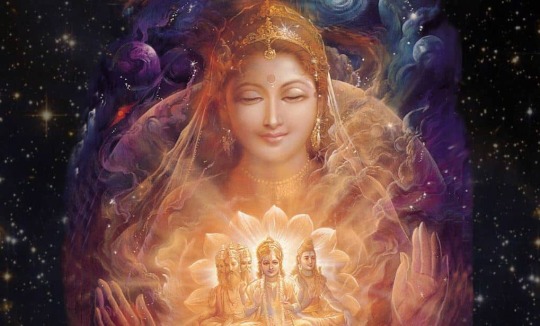
21 notes
·
View notes
Text

Krama [ (क्रम), kālī-krama (काली-क्रम) ]
__________________________________________
Krama or Kali-Krama is a spiritual tradition, an integral part of the theological school of Trika , which in turn is part of the religious and philosophical system of Kashmir Shaivism .
The key teachers of the Krama tradition, which are known to modern scholars, are Siddha Vatulanath (author Vatulanath Sutras), Abhinava Gupta and Maheshvarananda (identified with Gorakshanath ). Abhinavagupta unified Krama, Kula, Pratyabhijna and Spanda into a single system of Kashmir Shaivism. Therefore, according to one of the versions, Krama (as a Shaktopāya ) arose as an integral part of Kashmir Shaivism.
According to another version, the tradition of Krama existed before Vasugupta and other ancestors of monistic Kashmir Shaivism (that is, until the VIII century). According to this view, at that time Krama was divided into two large sampradayas - Sakhas (where the main practice was spontaneous awareness) and Chumma (where they learned the essence through sacral structuring).
Krama means in Sanskrit process, stage, sequence, turn. The basic idea of this system is that the way in which a person follows to reach God represents some steps (stages). Each stage is associated with a certain aspect of Shakti .
As Divine Higher Strength (Parashakti) Kali-Krama protrudes Kāli, there are 12 (13) its major manifestations, which form a coherent system through comprehension veneration of these aspects.
The highest state is manifested in Pramata (the knowing subject), Pramana (knowle- dge) and Prameya (knowable object), which correspond to the three shakti: Ichchha, Jnana and Kriya.
12 Kali is divided into these three categor- ies, respectively, in each of the three there are four manifestations of Kali. The four manifestations of Kali, in turn, reflect the five states of Shakti: Srishti - creation, Sthiti - preservation, Samhara - destruction, then an indescribable, transcendent state of Anakhya and Bhasa or Pratibha(it is also called Chiti or Svatantrya Shakti).
However, the fifth Shakti is identical to the transcendental Shakti and therefore corre- sponds to the 13th Kali, which is the center of the chakra (circle), consisting of the 12th Kali. Creation, preservation, destruction and the beyond, is manifested in the Shakti Chakra as follows:
[1]. Prameya (knowable subject):
1) Srishtikali - the creation of the object of knowledge in Parasamvit. Srishti.
2) Raktakali - preservation of the object of knowledge, which is the external manife- station of the subject himself. Sthiti
3) Sthitinashakali - the disappearance of the object, that is, the completion of its own existence, its external manifestation. Samhara.
4) Yamakali - when transcendental consciousness goes beyond the limits of perception of objects of knowledge and at the same time all processes in them, as distinct from themselves. Objective transcendence. Anakhya
[2]. Pramana (cognition):
5) Samharakali - this state is somewhat similar to Srishtikali in that the object is being perceived, but in Srishtikali the object is different from you, and in Samharakali it is also different and you. Srishti
6) Mrtyukali is a process of knowing the disappearance of the appearance of an object in itself, but at the same time the object does not collapse, but returns to its source, through which it manifested itself. Sthiti
7) Rudrakali - the ability to transform experienced objects stored in memory, for example, in the process of acquiring more perfect, transcendental knowledge. Samhara.
8 ) Martandakali - a group of twelve indriyas , including the five senses of perception, the five organs of action, manas and buddhi , is like the shining of the sun. Ahamkara or Ego, despite the fact that in other contexts it is recognized as an inner feeling, it is not considered as such here, because it is identical with the subject ( pramata ), because it has every object that the indriya can relate to. All indriyas function only when they are connected with Ahamkara, just like an ax acts when it interacts with the hand. ( ahamashaspar- shitaya pramátra-bhedini. TA, III, 177).
Thus, Martandakali is nothing more than Parasamvit because it leads to the merging of the twelve indriyas listed above in Aham- kara, where they completely lose themsel- ves and become nameless. For the same reason, the Martandkali corresponds to the Anakya Shakti ( ankhyamitya- khyashun- yamucyate ......... tacca tattvadrishtya samhritanam pramatradinam samhartrisv- abhavasamvidagnimatra parisheshyarupa- taya nisciyate. Mahartha Manjari., 103-4 ). Anakhya.
[3]. Pramata (knowing subject) :
9) Paramarkakali - the power by which the enlightenment of all aspects of the true "I" occurs. It is a creative force in relation to its limited and transcendental ego. Srishti
10) Kalagnirudra kali - also called Mahakali , because it contains everything within itself, not excluding even time. Awareness of the integration of your own "I" with all its eternal aspects. Sthiti
11) Mahakalakali - an experience that characterizes Mahakalakali - "I am all that." But there is a higher experience in which the element "it" is missing. The difference between these two experiences is that in the first "I" rests on "this", and in the last "this" exists without the "I", remaining within itself.
Parasamvit is called Mahakalakali, because it produces the fusion of "I", which shines as opposed to "this", as well as "I am all that" - in "Pure Self", "Perfect I", " Shark ", which is free from all relationships with "objectivity", "this". It represents the power of the destruction of the subject. Samhara.
12) Mahabhairava-chandogra-gkhorakali - “Perfect Self”, subject, object, means of knowledge and knowledge, are in complete identity with pure self- consciousness. Anakhya.
Thirteenth Kali is that Shakti, which in Naths is defined as Nija-Shakti , which is identical with the Absolute itself, transce- ndent in relation to the object, the subject and their relationship, in relation to the relationship between the Purusha and the transcendental self.
She embraces everything, She is beyond all things, independent of any definition. She is the unity of the Atman , which is aware of itself in the highest degree through Paramatma . But this Shakti is not separate from the Jivatma , and thanks to it, (by knowing her )the yogi becomes liberated during life. Nathas call it “ Adesh, ” which implies the perfect state of the identity of Atma, Jivatma and Paramatma. This is the highest power.
Source : Nathas.org
4 notes
·
View notes
Text
அவர்களில் ஒருத்தி ஏழுலகத்துக்கும் ராணி எனத் தகும் கம்பீரத் தோற்றமுடைய பெண்மணி. இன்னொருத்தி வீணைத் தந்திகளில் விரல்களை ஓட்டி இன்னிசை எழுப்பிய நங்கை. இருவரும் அழகிகள் என்றாலும் ஒருவருடைய அழகுக்கும் இன்னொருவருடைய அழகுக்கும் மிக்க வேற்றுமை இருந்தது. ஒருத்தி செந்தாமரை மலரின் கம்பீர சௌந்தரியம் உடையவள். இன்னொருத்தி குமுத மலரின் இனிய அழகை உடையவள். ஒருத்தி பூரண சந்திரன்; இன்னொருத்தி காலைப் பிறை. ஒருத்தி ஆடும் மயில்; இன்னொருத்தி பாடும் குயில். ஒருத்தி இந்திராணி; இன்னொருத்தி மன்மதனின் காதலி. ஒருத்தி வேகவாஹினியான கங்காநதி; இன்னொருத்தி குழைந்து நெளிந்து செல்லும் காவேரி.
Kalki. Ponniyin Selvan: Giri Publications (Tamil Edition) . கிரி டிரேடிங் ஏஜென்ஸி பிரைவேட் லிமிடெட். Kindle Edition.
In these two women, one looked like the bold beauty who could rule all seven worlds, while the other was the beauty who had played the veenai with delicate, flower-like fingers, awakening melodious music. The two were both absolute beauties, but there were differences in their respective beauties. One had the bold beauty of the red lotus bloom, while the other had the serene and pleasant beauty of the kumudha flower. One was like the full moon, while the other held the beauty of the crescent moon. One held the beauty of the dancing peacock, the other held that of the song bird. The former was like Indrani, while the latter held the beauty of Manmadha's beloved, Rati. One was like the speedy river Ganga, while the latter was like the gentle, meandering Kaveri.
I adore this passage, for it brings out the equality of Kundavai and Vanathi without compromising either.
The main reason I shared this is to focus a little more on Vanathi here- there are loops Kalki has opened here with regards to Arulmozhi Varmar here. Her delicate kanthal flowers is something Arulmozhi himself remarks on during the love confession. She is compared to the crescent moon, which is more powerful a symbol in Shaiva tattva, for the crescent moon is considered a symbol of ParaShakti- it could indicate the ShivaShakti equality in Vanathi and Arulmozhi- which is also indicated when they all go to Thiruvaiyaaru, albeit indirectly.
Calling Vanathi comparable to Rati makes sense when Arulmozhi is constantly compared to Manmadhan through the books. And the last comparison, to that of the Kaveri/Ponni, is the most significant one- though I will make a separate post expanding on it, as it requires multiple citations to establish that theory.
Let me know what you all think!
@vibishalakshman @thelekhikawrites @nspwriteups @whippersnappersbookworm @ragkee @chemicalmindedlotus @dr-scribbler @willkatfanfromasia @balladedutempsjadis @freeunknownwasteland @ramcharanobsessed @gemmusings @vijaysena @thirst4light @hollogramhallucination @chiyaanvikram @moon-880 @sakhiiii @thereader-radhika @ambidextrousarcher @celestesinsight @yehsahihai @thegleamingmoon @dumdaradumdaradum @rang-lo @yehsahihai @ragkee
#ponniyin selvan#arulmozhi#kundavai#vanathi#vanathiarulmozhi#aditha karikalan#ponniyin selvan 2#vanmozhi#vanthiyathevan#nandini
31 notes
·
View notes
Text
youtube
Maa Siddhidatri is worshipped on the ninth day of Navratri. According to Hindu mythology, Rudra worshipped Adi-Parashakti, the supreme Goddess of Power, when the universe began. Since she had no form, Adi-Parashakti appeared in the form of Siddhidatri from the left half of Lord Shiva. When this happened, Shiva came to be known as Ardha-Narishwar.
#youtube#goddess durga#durga puja#durgamaa#hinduism#nav durga#navdurgas#navratri#navratrispecial#divine feminine#maa siddhidatri#festival#hindublr#hindu mythology#hindutva#hindusim#sanatani
2 notes
·
View notes
Text
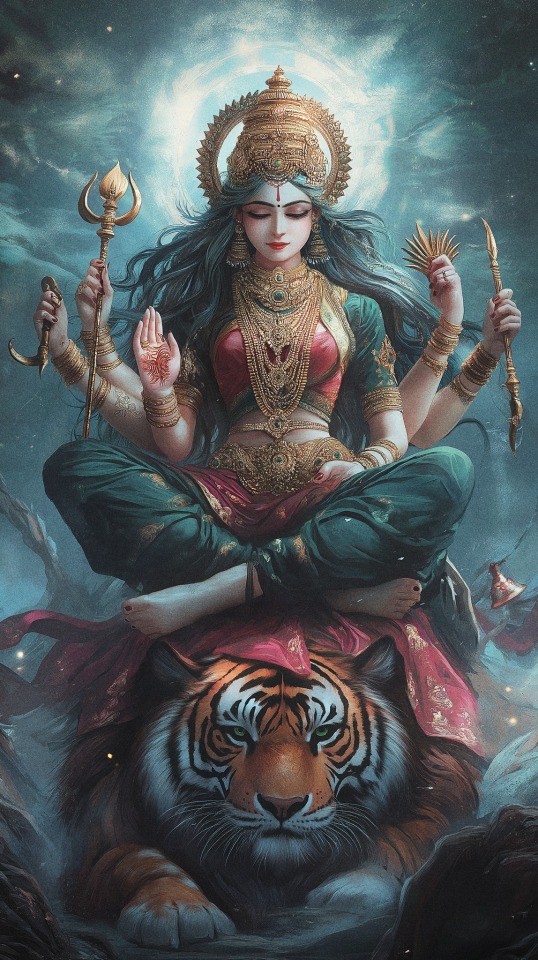
Durga
In Hinduism, the goddess Durga, also known as Shakti or Devi, is the protective mother of the universe. She is one of the faith's most popular deities, a protector of all that is good and harmonious in the world. Sitting astride a lion or tiger, the multi-limbed Durga battles the forces of evil in the world.
Durga is the ultimate feminine power. She is the embodiment of all Shaktis, the combined divine energies of the supreme Goddesses, Saraswati, the divinity of knowledge; Lakshmi, the one of wealth; and Parvati, the Goddess of might and valor. She is Adi Parashakti, the pre-eminent Goddess and is known in many other names such as Rajarajeswari, Kali, Mahishasura Mardhini, etc.
‘The Fort’ is the literal meaning of the word Durga, while the name as such denotes someone ‘who is invincible.’
Goddess Durga Mantra
‘Om Dum Durgayei Namaha’
Benefits of Chanting Durga Mantra
This is considered a mantra of divine protection. This is a powerful hymn, which can be chanted aloud and also meditated upon internally. It is believed that its faithful recitation with devotion, humility and total trust in the ultimate power of the divine mother can get for the devotees the immense blessings of Maa Durga.
32 notes
·
View notes
Text
#संसार_के_रचियता_कौन_हैं
#NOIDAGBNUP16
The Creator of All, Supreme God Kabir
Atharvaved Kaand no.4 Anuvaak no.1 Mantra no. 2 The Universal Supreme Father God with Hisword-power created Rashtri, that is, the First Maya Rajeshwari. And through that Parashakti only, He has established all the universes with the never-ending quality of holding each other with an attractive force.

2 notes
·
View notes
Text

Durga
In Hinduism, the goddess Durga, also known as Shakti or Devi, is the protective mother of the universe. She is one of the faith's most popular deities, a protector of all that is good and harmonious in the world. Sitting astride a lion or tiger, the multi-limbed Durga battles the forces of evil in the world.
Durga is the ultimate feminine power. She is the embodiment of all Shaktis, the combined divine energies of the supreme Goddesses, Saraswati, the divinity of knowledge; Lakshmi, the one of wealth; and Parvati, the Goddess of might and valor. She is Adi Parashakti, the pre-eminent Goddess and is known in many other names such as Rajarajeswari, Kali, Mahishasura Mardhini, etc.
‘The Fort’ is the literal meaning of the word Durga, while the name as such denotes someone ‘who is invincible.’
Goddess Durga Mantra
‘Om Dum Durgayei Namaha’
Benefits of Chanting Durga Mantra
This is considered a mantra of divine protection. This is a powerful hymn, which can be chanted aloud and also meditated upon internally. It is believed that its faithful recitation with devotion, humility and total trust in the ultimate power of the divine mother can get for the devotees the immense blessings of Maa Durga.
12 notes
·
View notes
Text
Why Do So Many Gods Coexist in Hinduism?
Hinduism beautifully embraces diversity, allowing countless Gods to coexist. Why? Because different people have different temperaments and preferences. Each devotee connects with their chosen deity (ishta), forming a unique and personal bond.
The beauty of ishta-nishta (steadfast devotion) lies in its inclusivity—whether one worships Shiva, Vishnu, Devi, or Muruga, every path leads to the same divine truth. The Shiva Purana declares Shiva as supreme, Devi Purana says the same about Parashakti, and Vishnu Purana glorifies Vishnu. Each scripture strengthens devotion, not division.
Some may argue over which God is supreme, but in time, spiritual maturity unfolds, revealing the deeper unity in diversity. It may take lifetimes, but the journey itself is sacred.
In the end, Hinduism teaches that God is one, yet manifests in many forms—each offering blessings and solace to devotees.

#blogger#blogs#blog#tumblog#my writing#blogging#india#reading#hindu#spirituality#faith#hindusim#hindublr#hindu mythology#hindu gods
2 notes
·
View notes
Text
Dakshineswar Temple
Situated on the banks of the holy river Hooghly, West Bengal, India, is the temple of Bhavatarini, a form of Parashakti Adya Kali, otherwise known as Adishakti Kalika- well known as Dakshineswar Kali Temple. Rani Rashmoni, a Zamindar, philanthropist, and devotee of Kali Maa, erected the temple in 1855. The temple is well-known for its connections to Bengali mystics Ramakrishna and Ma Sarada Devi from the 19th century. Profoundly affected by the visionary dream of the Goddess Kali, Rani Ma searched for and purchased a 30,000-acre tract in the Dakshineswar village from Jake Hastie, an Englishman, who sold the 20-acre site, which at the time was known as Saheban Bagicha. Between 1847 and 1855, a sizable temple complex was constructed.
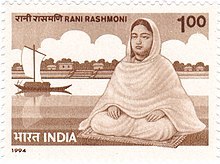
The primary temple was modeled after the Radhakanta temple in Tollygunge, designed in the Navaratna style by Babu Ramnath Mondal of the Bawali Raj family.
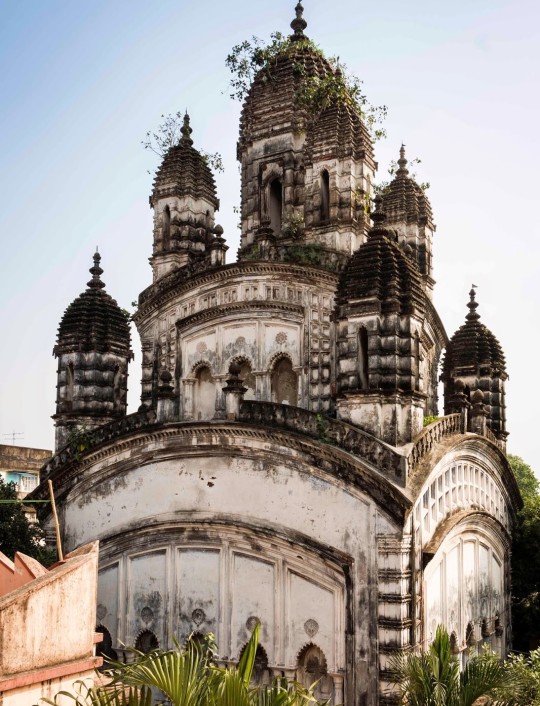
Radhakanta temple in Tollygunge
In addition to the main temple at Dakshineswar with nine spires, the temple compound also has rooms along the perimeter walls of a sizable courtyard. The garbha griha, or sanctum sanctorum, has the idol of Bhavatarini perched atop Lord Shiva. Both idols are set atop a pure silver lotus blossom with a thousand petals. Along the riverfront, there are twelve shrines to Shiva, Kali's consort, a Radha-Krishna temple, a riverside bathing ghat, and a shrine to Rani Rashmoni.

The Shiva Temples
The three-story, south-facing temple was constructed in the Bengali architectural style known as Navaratna, or "nine spires," and it has nine spires scattered throughout the upper two storeys. It is elevated on a high platform and has a flight of stairs leading up to it. It is 46 feet (14 m) square overall and rises to a height of more than 100 feet (30 m).
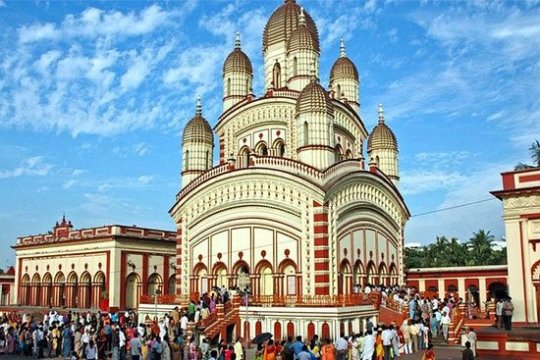
Dakshineswar Temple
#architecture#history#design#india#writing#culture#writers on tumblr#writing community#navaratna#west bengal#bangla#bengali#indianarchitecture#bengal architecture
4 notes
·
View notes